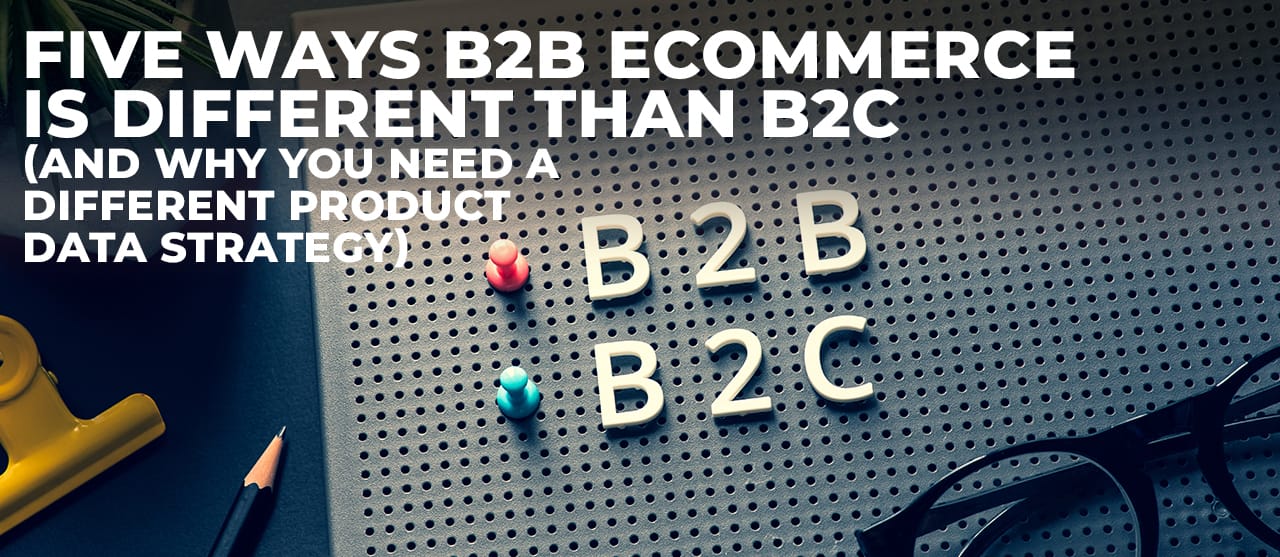
The belief that B2B transactions are similar to B2C is nothing but a widely perpetuated misconception. Not only are the former markedly complex, but they also bear a completely different strategic flavor courtesy of emphasis on product-specific data. Add the pandemic’s impact on consumer behavior into the mix, and the gap becomes even more profound.
Sure, the core component of such an impact across B2B and B2C domains is rapid digitization, but that doesn’t define the more granular dissimilarities between them. B2B companies, in the new normal, are having to micro-segment to cater to highly fragmented markets more than ever before. That only reiterates the requirement for a more cohesive strategy with respect to product data.
But the same cannot be said about B2C eCommerce, at least not in the same way. In fact, brands doing B2B transactions might be attracted to a ‘long tail’ model where the key is product discovery and distribution. The key to capitalizing on such a model is mapping product data from multiple sources alongside understanding the business context holistically.
Jonathan Byrnes and John Wass, from Harvard Business Review, outline that the “key to survival in the post-pandemic period and throughout this new era is to use the data you have readily available to identify your profit peaks and profit drains,” and rightly so. But first, there’s a need to understand why the product data strategy for B2B should differ from what’s usually practiced for B2C.
So, what are the differences, and how exactly do these differences manifest themselves in the form of product data? Let’s take a look.
1) The Decision-Making Process Is More Incremental In Nature
While the B2C purchaser makes a single, final decision on the spot, the B2B buyer proceeds with no less than four to five individual decisions – before eventually arriving at the final one. As such, the B2B buyer is more skeptical and careful than the B2C one.
Instead of making immediate decisions, buyers will ponder their needs, needs of their customers and competitors, taste in terms of quality and delivery time, budget constraints, etc. All these elements become crucial for the B2B seller to address, thus, exhibiting the need for an in-depth holistic product data strategy.
2) The Product Data Is More Complicated
In general, the B2C buyers have a simple database of product attributes, with a straightforward categorization of goods, which they use to make a decision. On the other hand, the B2B buyers have a product data matrix that comprises numerous permutations. It is very difficult to present all intricacies of this matrix in a concise manner, but it is certain that the consumer viewpoint is as per the data as possible, as it pertains to their needs.
The complexity of the B2B product data can also be inferred by the requirement to amalgamate a number of data sources. For instance, B2B data can be sourced from the company’s CRM or perhaps from a product catalog that is being distributed to partners or even from a data-driven marketing program. This data can further be categorized as firmographic, technographic, intent, and behavioral. All these ingredients come together to form one complete product data structure.
3) The Decision To Buy Is Based On The Product’s Value Proposition
The B2B decision-making process very tactfully goes beyond mere product specifications. Most often, what the customer looks for is the value proposition of those product specifications, and not solely the product. The B2B buyer is less driven by the product and more by how the product meets his/her business needs. Thus, a holistic value proposition comprising product value and non-product value plays a pivotal role in the B2B buyer’s decision-making process.
Also, the price factor takes a back seat in such transactions. The B2B strategy aims at retaining the customers for future transactions, which can materialize only if the seller is capable of delivering superior non-product values. This necessitates a detailed product data strategy that focuses on comprehending the business context first.
4) The Product Data May Not Be As Visual
Visuals play a huge role for the B2C buyer. For example, visuals such as those of an iPhone, a pair of jeans, and a laptop can make or break the product decision. These visuals are not only influential in driving sales but also act as an ice-breaker when done with style. The likes of Facebook, Pinterest, and Instagram have taken the world by storm for precisely this reason.
The B2C product data strategy, therefore, focuses on the visualization of all products with great emphasis given to technical details, prices, and discounts. But when it comes to B2B eCommerce transactions, visuals may not be so important. Of course, companies offer insights into the tool’s workings.
For instance, IBM or the like would certainly provide visualizations of the dashboard, but the emphasis is more on the product’s role in terms of business solutions. For that reason, most of the B2B products are intangible, complex, and specialized. What would be highly visual in a B2C deal quickly loses its appeal when applied to B2B transactions.
5) The Need For Data Validation Is Greater
The B2B data validation process is a two-way street. On the one hand, there’s the need to verify whether the product matches the specifications desired by the buyer. On the other hand, there’s also the need to track whether the specifications match what the product needs. After all, it is important that the seller understands if his/her product is capable of meeting all business requirements or not, especially when the idea of custom solutions is perhaps the USP or a significant driver of the USP.
What Should A Unique B2B Product Data Strategy Encompass?
1) Well-Rounded Product Descriptions
The B2B data strategy must be well-rounded, as much as the product itself. It can’t be any other way since holistic product description is the only way to comprehend the complete feature set of a product. To that end, here’s how it should turn out:
- Buyer’s business context, i.e., the question must be addressed – What are the business needs?
- Both tangible product characteristics and intangible value proposition characteristics must be enumerated
- Images and videos must be attached to the product data for a more visual experience
- The product data must be kept simple and uncluttered for ease of consumption – Readability must be prioritized while keeping the language prowess intact
2) Tiered Product Information
Product information is available in many permutations. It can be classified based on the buyer’s needs, or it can be categorized based on the product’s value proposition. It’s not always necessary to display all information, but depending on the buyer’s needs, there must be a scalable modus operandi. For example:
- If the product is a premade solution, then this information must be provided in one place
- If the buyer is customizing the product, then this information should be customized in step with his/her customization
- If there are several versions of the same product in the market, then different versions must be organized with the same system of classification
- Geographical locations must also be factored in. If the buyer is internationally based, then this information must be provided in the same manner in all territories
3) Product Lifecycle Management
Product maintenance, deployment, and replacement are crucial aspects of the B2B product data strategy. For example, changes in the product can be implemented based on the buyer’s feedback. This requires a smart inventory management system that can track this data to ensure product delivery consistency.
4) Issue-Tracking/Issue-Resolution/Customer Service Configuration
Product issues have a direct impact on the buyer’s business. In that light, the B2B product data strategy must incorporate a mechanism to address these issues. For example, a product issue may have been overlooked, leading the buyer to incur a loss. In such a scenario, the seller must ensure that the buyer is not deprived of product delivery and/or help in fixing the issue on time. This can be accomplished through regular monitoring of the product’s interaction and associated performance.
Conclusion
A spate of startups and businesses have already recognized the same bellicosely and adapted their eCommerce strategies accordingly. However, several others, still subscribing to the mainstream belief, are struggling with a plethora of challenges that come as an aftermath of their misguided approach.
At EnFuse, we believe that eCommerce product data strategy is a crucial component of the business growth strategy. To that end, we help organizations make intelligent decisions while exploring, designing, testing, launching, and managing products.

















Comment